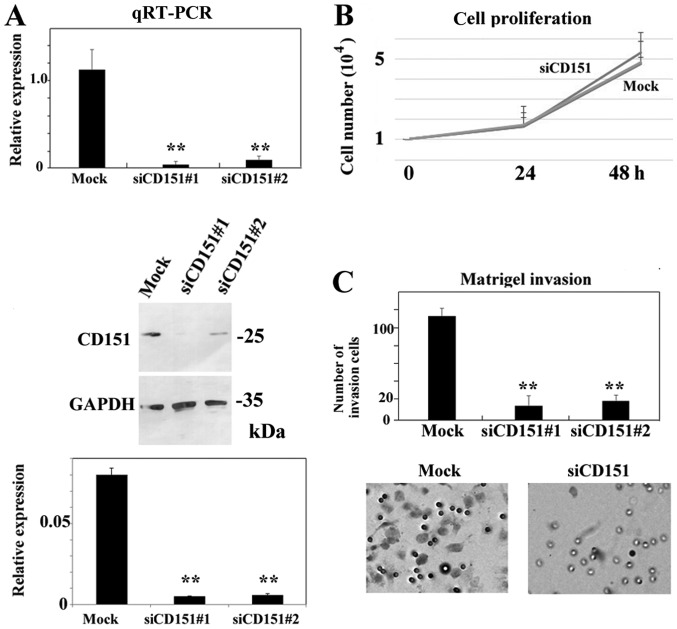Figure 3.
siRNA-mediated gene-silencing of CD151 does not affect cell proliferation, but significantly decreases Matrigel invasion activity of HS-MMhigh in vitro. (A) Both SI02777257 (indicated by siCD151#1) and SI02777250 (indicated by siCD151#2) siRNA treatments reduced CD151 expression at both mRNA and protein level. Reverse transcription-quantitative-polymerase chain reaction indicated that both SI02777257 and SI02777250 significantly reduced CD151 expression. Immunoblotting also demonstrated little CD151 protein in SI02777257 and SI02777250 siRNA treated HS-MMhigh cells. The intensity ratio of each band to GAPDH is shown. The data represent the mean ± SD of triplicate assays. ANOVA, Tukey's t-test. was performed to confirm the significant differences, **P<0.01 vs. Mock group. (B) Representative cell proliferation assay using siRNA targeting CD151. At 24 h, the cell number was 1.67±0.47 (Mock), 1.67±0.67 (SI02777257), 1.73±0.35 (SI02777250). Respective numbers at 48 h were 5.33±0.75 (Mock), 4.77±0.30 (SI02777257), and 4.83±1.07 (SI02777250). The data represent mean ± SD in triplicate assays. ANOVA, Tukey's t-test. P>0.5). Data using Mock and SI02777257 siRNAs are shown in this cell proliferation line graph. (C) SI02777257 and SI02777250 siRNAs specific to CD151 significantly reduced Matrigel invasion activity of HS-MMhigh cells. The number of invading cells was 113.7±6.42 (Mock), 13.7±8.33 (SI02777257, indicated by #1), and 19.3±11.0 (SI02777250, indicated by #2). Data from triplicate assay are expressed as the mean ± SD (n=3; ANOVA, Tukey's t-test. **P<0.01 vs. Mock group). A representative image of Matrigel invasion assay using Mock and SI02777257 siRNAs are shown. Cells that migrated to the undersurface of the membrane are shown. Original magnification, ×100. CD151, cluster of differentiation 151; SD, standard deviation; siRNA, small interfering RNA.

